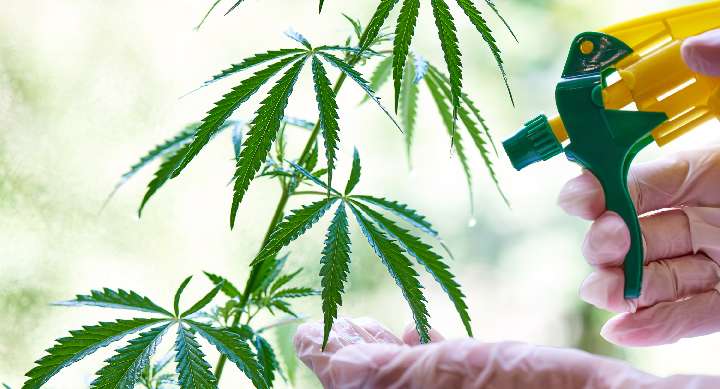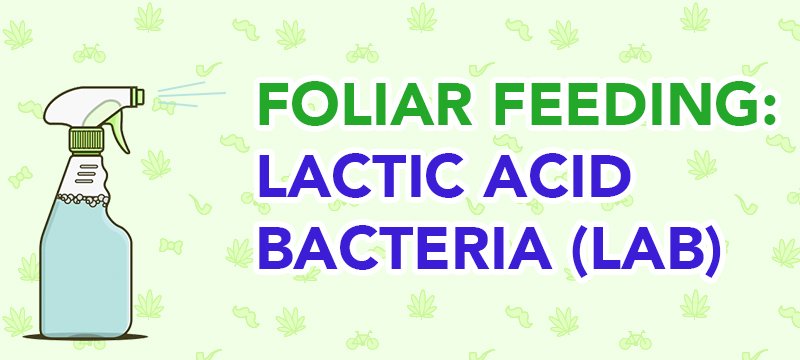
Organics in gardening, dining, and every other aspect of what we ‘consume’ has been steadily gaining in popularity. When it comes to cannabis there have always been arguments about whether organic or synthetic gets better yields, keeps plants happier, etc.
What if you could use one simple mixture, that you can make yourself very easily?
What if it doesn’t matter whether you are 100% organic or running a hydro garden with only synthetic nutes?
What if said mix could increase your yield as well as the quality of your cannabis plants?
Maybe you’ve heard of Lactic Acid Bacteria (LAB) and maybe you haven’t. But the bottom line is that you need to go through this article and start foliar feeding your garden with LAB as soon as possible, and we’ll share a few reasons why.
Don’t want to make your own LABs? Checkout these ready-made products with similar results.
- THE #1 ALL-NATURAL ORGANIC PROBIOTIC FOR YOUR PLANTS & SOIL is finally here to improve texture and drainage for soils, while promoting growth for your plants, flowers, trees, shrubs, and garden.
- IMPROVE WATER QUALITY IN YOUR PONDS & AQUARIUMS with our non-toxic and safe em-1 microbial inoculant. This non-GMO and easy-to-use probiotic inoculant will effectively enhance water quality thanks to its effective live microorganisms.
Last update on 2025-04-11 / Affiliate links / Images from Amazon Product Advertising API
Implementing Lactic Acid Bacteria falls under organic gardening techniques. Organic cannabis cultivation foregoes salt-based chemical fertilizers in favor of nurturing the soil’s “micro-herd. That doesn’t mean force-feeding a bunch of mini-cows. The micro-herd is a complex community of beneficial microbes including bacteria, fungi, algae, yeasts, and other organisms.
With this type of gardening, you feed the herd, and as the microbes digest their food, the byproducts feed your plants. This natural technique is perfectly balanced and virtually eliminates problems like overfeeding, deficiencies, and nutrient lockout—when done properly. You don’t even need to worry about pH levels. Foliar feeding makes LAB more available to the entire growing environment which of course is good for your plants and is the preferred method of delivery.

What is Lactic Acid Bacteria (LAB)?
Lactic acid bacteria is a food-safe microbe that’s used to make yogurt, pickles, and other fermented foods. Sometimes, food processors also use Lacto b as a sanitizer. When added to either a liquid or solid that contains some type of sugar, LABs consume and digest the sugar, then excrete lactic acid as a metabolite or byproduct.
These microbes not only do no harm, but they’re also as good for you as they are for your cannabis plants. You have lactic acid bacteria in your own personal micro-herd that live in your digestive tract, and many doctors recommend adding a probiotic supplement containing Lacto b if you have ongoing stomach problems. Eating yogurt on a regular basis helps too.
How can LAB Improve my Garden and overall marijuana plant health?
In theory, the addition of lactic acid bacteria to your organic growth will increase both the trichome and terpene production. This theory is backed up by real scientific research that you can read for yourself in the Plant Journal, and on the NCBI.
As your LABs digest sugars, they create a short-chain fatty acid called hexanoate as a byproduct. Cannabis plants synthesize hexanoate to produce terpenes and cannabinoids. By introducing more hexanoate, you provide essential building blocks for more terpenes, more cannabinoids and, in theory, more THC. So the result, put extremely simply, is better smelling and tasting marijuana along with a more potent high.
There are plenty of other studies that discuss how using Lacto b can increase growth by generating organic fertilizers that are more bioavailable as well as preventing disease by suppressing multiple types of bad fungi and bacteria. The endgame, once again is bigger, healthier cannabis plants that create massive yields.

How do I add LAB to my grow? Foliar Feeding
If you’re growing organically and use the no-till method, your soil probably already contains lacto b. Lactic acid bacteria are everywhere, so they’ll be introduced to your soil as leaves and other material reach the garden surface and decay. LABs that are already present in your soil are feeding on old organic matter as well.
Most of the lacto b in your soil can be found within the top 5-6 inches of the soil because it needs a tiny amount of oxygen to survive. Microbes that fall into this category are called soil-borne facultative anaerobes. The idea is that you should be able to greatly improve your soil and root zone from the surface by adding lactic acid bacteria if you so choose, but not everyone agrees this is possible.
DIY Hydroponics System – Build one today!
You can add lactic acid bacteria mixture (LABS) to water and spray it on the soil or directly on the plants.
What should I avoid when using Lactic Acid Bacteria on my plants?
When trying to promote a healthy micro-herd, avoid applying salt-based chemical fertilizers to your soil. They will kill most of your beneficial microbes while allowing some of the harmful ones to survive.
Avoid disturbing the soil as much as possible. The largest amount of LAB will be just beneath the surface, and exposing them to UV light can kill them. That’s also why you should only apply lactic acid bacteria at night or right before you turn your lights off.

Make your own Lactic Acid Bacteria – Lactic Acid Bacteria Recipe
You can culture your own lactic acid bacteria mixture using mostly items you probably already have at home. Here’s how you do it:
Materials
- Wide-Mouth Mason Jars – 64oz
- Cheesecloth(s)
- Rubber Band
- Paper Bag
Ingredients
- 1lb Rice
- Chlorine-Free Water
- 1 quart Organic Milk (commercial milk may contain antibiotics)
Directions
- If your water is chlorinated, let it sit out for 24 hours so the chlorine can dissipate, if you don’t already have a chlorine filter – get one, extremely important for your garden when using LAB
- Put equal amounts of water and rice in a jar.
- Shake well, then strain through cheesecloth into the second jar. The water should be milky-looking.
- Cover the jar with a fresh piece of cheesecloth and secure with a rubber band.
- Place the jar in a paper bag or wrap it with a cloth to seal out the light.
- Let the jar sit in a warm, dark place.
- Check daily for the residue to settle at the bottom, and for the mixture to have the sour smell that tells you fermentation has started. It will take 2–3 days if the temperature stays in the 77-86°F range. Otherwise, this step could take a week or longer.
- Pour the milk into a new jar.
- Pour the fermenting rice water into the jar, straining through a clean piece of cheesecloth.
- Cover the jar with more cheesecloth and secure with a rubber band or the jar top. Make sure it’s secure, but there’s still airflow.
- Put the pitcher in a paper bag or wrap it with a cloth to seal out the light.
- Place it in a cool, dark place.
- Check once a day until you see three distinct layers form. This can take up to a week.
- Scoop out the top layer (the curd) and discard.
- The mixture (the whey) will be the middle layer that has a clear/light yellow color. Slowly pour off the mixture into a clean jar, straining through cheesecloth again. Be careful not to mix in any of the bottom (sediment) layer.
- Seal the jar loosely so gas produced by the ongoing fermentation can escape.
- Place in the refrigerator. It is now ready to mix and use in your garden.
The mixture is alive. It will continue to produce small bubbles and should have a mild sweet/sour aroma. If it smells like it’s rotting, the mixture is contaminated and needs to be thrown out and you should start over.
Foliar Feeding Lactic Acid Bacteria (LAB) Application
To use, dilute the mixture by adding 110ml to 1 gallon of dechlorinated water, and add to spray bottles. One batch of the mixture can make up to 130 gallons of foliar spray.
If you can’t refrigerate your mixture, you can stabilize it by adding an equal part of molasses or brown sugar to the mix. This gives your LAB culture something to feed on while waiting to be used on your cannabis plants. Practicing foliar feeding weed to nourish your plants and using a proper foliar spray for weed will help your plants thrive.
Apply your LAB by foliar feeding and spraying the tops of the soil if growing in soil, 1 to 2 times per week. LAB is the best foliar feeding nutrient you can give your plants by a long shot. It is cheap to make yourself and it delivers incomparable results. Try it, you’ll thank us later.
- ALL NATURAL ORGANIC PROBIOTIC for your plants and soil is finally here to improve texture and drainage for soils, while promoting growth for your plants, flowers, trees, shrubs, and garden. PLEASE NOTE the expiration date on the bottle.
- IMPROVE WATER QUALITY IN YOUR PONDS AND AQUARIUMS with our non-toxic and safe EM1 microbial inoculant. This non-GMO, user-friendly probiotic inoculant will enhance water quality thanks to its effective live microorganisms.
- 1 MILLION COLONY-FORMING UNITS OF LACTIC ACID BACTERIA will help eliminate foul odors (pet, smoke, garbage or paint smell) while conditioning your soil for organic lawn care.
Last update on 2025-04-11 / Affiliate links / Images from Amazon Product Advertising API
Checkout all of the grow gear and equipment we use in our garden to help our plants thrive.
Is lactic acid bacteria a probiotic?
Yes, lactic acid bacteria is a probiotic for plants and animals when used in moderation.
Is lactic acid bacteria harmful?
Lactic acid bacteria is no harmful to plants and animals if applied and used in moderation.
Is lactic acid bacteria good or bad?
Lactic acid bacteria is generally considered a good thing. Like everything else, it is good in moderation.
What is lactic acid bacteria used for?
Lactic acid bacteria (LAB) is good for a wide range of applications: human consumption for ‘cleansing’ and maintaining digestive system, keeping animals digestive systems clean, as well as providing beneficial bacteria to plants and plants root systems.




